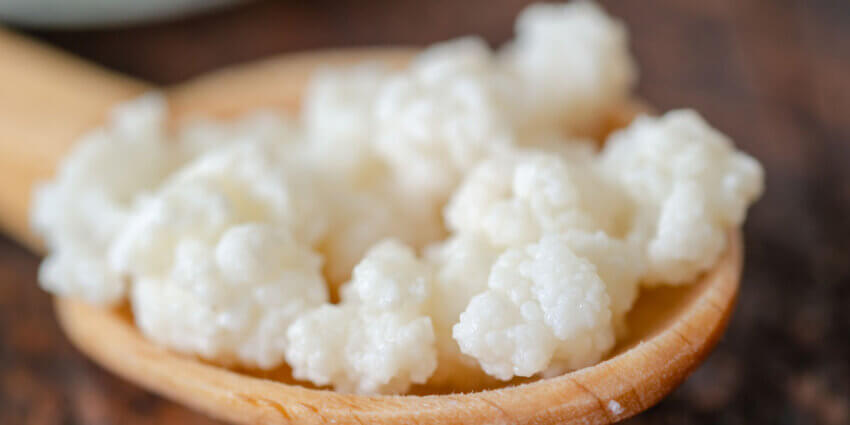Kefir Instructions – 2 Quart Mason Jar
Ingredients:
- 2 TBSP to 1 cup of good quality kefir grains #1
- 2 quart mason jar with lid/ring
- 2 quarts whole organic milk (grass fed is best) #2
- Paper towel
- Rubber band
Instructions:
- Add kefir grains to a clean empty 2 quart mason jar
- Pour milk to neck of 2 quart jar
- Cut a paper towel in to quarters
- Put one section of the quarter cut paper towel over the top of the jar
- Secure paper towel square with a rubber band (or you can screw the jar ring (without the lid) over the paper towel)
- Let this ferment on the counter at room temperature (68-75℉ is best, but up to 5-7℉ either side is OK) for 24-72 hours (48 hours is best for denaturing the casein proteins to render safe for those sensitive to them). Keep out of direct sunlight. #3
- Remove the paper towel and put a solid lid on the jar.
- Shake the jar well for at least 30 seconds. This will separate the grains from the curds, recombine that curds and whey, and allow the grains to be removed more easily.
- Remove kefir grains with a slotted spoon into new jar and begin the process over in new jar.
- The kefired milk (in the 1st jar) is now ready to drink, or you can put a lid on it and refrigerate for up to 2-3 weeks (really you can probably go much longer, the milk is now immunized from bacterial infection)
Notes:
Homemade Kefir can have up to 37 probiotic bacterial strains and 28 beneficial yeast strains. The number of strains and cultures (total bacteria count) contained in kefir is far higher than anything found in commercial probiotic supplements. Kefir is also an integral part of an anti-SIBO or candida protocol.
Some people may need a little time to get use to the taste and effervescence, adding a little stevia, vanilla extract, or cinnamon to it can really help. If you do a 48-72 hour ferment much of the milk sugars are fermented out (if you want it a little sweeter add a very small amount of stevia to it). A longer ferment like this also denatures the casein proteins so that most people with casein intolerance can handle this kefir recipe just fine (people with actual milk allergies still need to avoid dairy). I sometimes blend in some fresh or frozen blueberries and a little stevia in to the kefir (at the end of the process) before putting it in the refrigerator. Makes for a very yummy drink.
Footnotes:
#1: Try to order grains that have only been fed organic–grass fed–whole milk (or as close to that as you can find). I do not recommend dehydrated grains, only purchase live grains. Kefir grains will actually do OK on any milk, but long term they thrive better on grass fed whole milk.
If you’re looking to purchase grains try to get the best. I recommend buying those that have been fed organic whole milk. Etsy.com is a very good place to find grains, this is where I last purchased mine. If you are having trouble finding grains try the Facebook group “Kefir grains, Scoby and others to share” (look in the files section), people there will often share real grains (not dehydrated) for the cost of postage (be sure look for “Milk Kefir” grains. You may also be able to find them locally on Craigslist (just search for “kefir”).
If using 2-4 TBSP of grains try to do a 72 hour ferment, especially if room temperature is colder. If using more grains (the little buggers multiply) then a 48 hour ferment is fine.
#2: If you make kefir from grass fed milk not only will your kefir grains be happier, but you will end up with kefir that has a lot of vitamin K2. Vitamin K2 is probably one of the best nutrients you can supplement as it can actually help prevent heart disease. You will also end up with a wider variety of probiotic strains, the kefir will taste better, and you will have a very good energy source. In a pinch you can use any milk, the grains will thrive better on whole milk (even if it’s regular commercial whole milk).
I would avoid raw milk for kefir as the competing bacteria in raw milk can hold back the kefir strains; some of those raw milk strains can really make the kefir taste bad.
#3: If you are lactose intolerant, have SIBO or candida, or are on a low FODMAP diet, you should ferment kefir for at least 48 hours. This allows the bacteria to consume all of the lactose sugar. If your home is cold (below 69 F) you may want to try 72 hours.
#4: “Issues” with Kefir – You need to become very accustomed to your symptoms. If your issues with Kefir differ at all from drinking milk then the issue may be more die off symptoms than dairy symptoms. Some people are also sensitive to histamine (HIT). Die off can be controlled through reducing intake, drinking more water, and sleep/rest (or just working through it). HIT can often be managed by consuming less histamine containing food, avoiding alcohol and taking a DAO enzyme replacement.
#5 Store bought – Store bought kefir is OK in a pinch. Just make sure it hasn’t been sweetened, and says it’s Lactose free (or 99%). I purchase Lifeway Greek Style Kefir [ii] (whole milk) when away from home, I find it to have the highest number of cultures and strains of any of the store bought varieties I’ve looked at. Just keep in mind homemade is going to better and cheaper.
#6 See Chapter 1 “I Can’t have dairy” – A case for dairy” as to why you can most likely consume kefir and hard cheeses.
[i] http://www.ebay.com/usr/mkselvaggio?_trksid=p2047675.l2559
[ii] http://lifewaykefir.com/products/greek-style-plain-whole-milk-kefir/
| These statements have not been evaluated by the Food and Drug Administration. This product is not intended to diagnose, treat, cure, or prevent any disease. |
All images posted by John Herron are either "Copyrighted John Herron", or are copyrighted by someone else and are used under license. So please don’t use them elsewhere, you’ll get in trouble.


 Phage Complete comes with a full 30 day money back guarantee, for U.S. purchases this includes the original shipping charges to you!
Phage Complete comes with a full 30 day money back guarantee, for U.S. purchases this includes the original shipping charges to you!
Can we substitute almond milk for this?
Yes. I haven’t tried it myself, but others have. However, people that are either lactose intolerance, or casein protein intolerant should be able to tolerate homemade milk kefir. Kefir made from dairy is healthier as it contains peptides that almond kefir (or water kefir) will not.
Do you know how many probiotic strains and beneficial yeast strains are in home made Water Kefir?